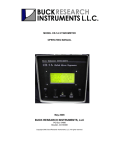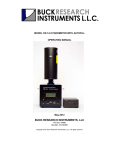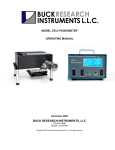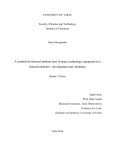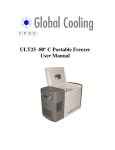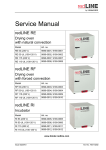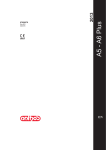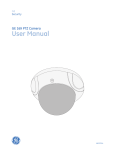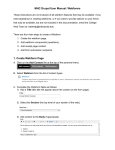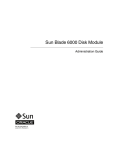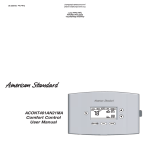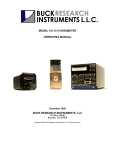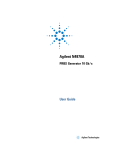Download UHQ-4P user`s manual - Buck Research Instruments LLC
Transcript
MODEL UHQ-4P HYGROMETER OPERATING MANUAL July 2014 (S/N >003) BUCK RESEARCH INSTRUMENTS, LLC PO Box 19498 Boulder, CO 80308 Copyright 2004-2014. Buck Research Instruments, LLC All rights reserved. - 2 - TABLE OF CONTENTS 1. Introduction .................................................................................................................. 4 1.1 General Description ....................................................................................... 4 1.2 Specifications ................................................................................................. 5 2. Location of Principal Components .............................................................................. 6 2.1 Main Unit ....................................................................................................... 6 3. Installation and Operation ........................................................................................... 3.1 Installation and Power-up Procedure ............................................................. 3.2 Operation ........................................................................................................ 3.3 Power-down Procedure .................................................................................. 8 8 8 9 4. Signal Processing ....................................................................................................... 10 4.1 Data Signals ................................................................................................. 10 4.2 Data Reduction Equations ............................................................................ 10 5. Principles of Operation .............................................................................................. 5.1 General ......................................................................................................... 5.2 Technical details ........................................................................................... 5.2.1 Sampling System ........................................................................... 5.2.2 Mirror Module ............................................................................... 5.2.3 Optics Module ............................................................................... 5.2.4 Cooling System ............................................................................. 5.2.5 Temperature Readout ..................................................................... 11 11 11 11 14 14 14 14 6. Measurement Limitations ........................................................................................... 15 7. Maintenance and Troubleshooting ............................................................................. 7.1 Sample line Cleaning ................................................................................... 7.2 Mirror Cleaning ............................................................................................ 7.3 Leak Testing ................................................................................................. 7.4 Troubleshooting Guide .................................................................................. 16 16 16 17 18 Appendix 1: Humidity Conversion Equations ................................................................ 19 Appendix 2: Connector Pin Assignments ....................................................................... 21 Appendix 3: Warranty ..................................................................................................... 22 Appendix 4: Instructions for using the CR-4 with sampling pump……………………...23 - 3 - FIGURES Fig. 1. Main unit ............................................................................................................................ 4 Fig. 2. Block diagram, UHQ-4P chilled mirror hygrometer ....................................................... 12 Fig. 3. Sensor assembly block diagram ....................................................................................... 13 - 4 MODEL UHQ-4P HYGROMETER OPERATING MANUAL 1. INTRODUCTION The UHQ-4P is a chilled mirror hygrometer with a heated sample chamber that is set for 160° C. This allows the instrument to read dew points from 40°C up to 100°C at a minimum pressure of 1013.25 mb (14.7 psia) and up to 150°C at 5000 mb . Dew points at lower pressures can be measured but are limited by the boiling point of water at that pressure. The UHQ-4P uses a heat sink and fan to cool a mirror pin to approximately 70°C below the sample chamber temperature of 160° C. The UHQ-4P is designed to measure humidity in air and most non-corrosive gases at pressures ranging from near vacuum to up to 100 psia. 1.1 General Description The UHQ-4P is a chilled mirror, condensation type hygrometer. It achieves its high performance by heating and cooling a mirror, using a heater wire and heat sink and fan assembly, and holding the mirror at the dew or frost point by means of a servo control system. An IR LED and optical detectors are used for sensing condensate on a mirror, and an ultra-stable temperature sensor imbedded in the mirror is used to determine mirror temperature--the dew point. Since operation of the UHQ-4P is based on a fundamental property of water vapor (dew point), it is intrinsically capable of long-term accuracy and stability, without the need for periodic recalibration. The UHQ-4P features an autobalancing function that automatically adjusts for mirror contamination. To keep a constant layer of dew or frost on the mirror, the reflectivity of the mirror must be measured when the mirror is completely cleared of condensation and when it is completely obscured by condensation. Once this is done, 20% of this span is calculated and set to be the control point. This is achieved by heating the mirror to a high enough temperature to remove condensation, then turning on and off the LED that shines on the mirror. If contamination ever gets to be enough that the control point cannot be achieved, another balance function will be initiated and the control point reset. Once the contamination becomes too great, an LED is illuminated to indicate that the mirror needs to be cleaned. The UHQ-4P is microcontroller-based. The microcontroller uses flash memory that is fieldprogrammable and updateable. If this is required, please contact Buck Research Instruments, LLC for instructions. The components of the UHQ-4P are: Main unit containing sensor assembly and display Power cable and 24 VDC brick power supply Data connector with pins Operating manual - 5 1.2 Specifications, Model UHQ-4P Chilled Mirror Hygrometer Measurement range: Dew point temperature: Moisture concentration: 40oC to 150oC 1 3% to 100% at standard pressure Dew point reading accuracy: + 0.2oC Response time (10 degree step): Less than 20 sec typical2 Nominal operating range: Ambient Temperature: Relative Humidity: -40 to +40oC 0 to 100% RH, non-condensing Flow rate of sample: 0.05 – 0.5 liters/minute Max pressure rating: 150 psia Output signals: Mirror temp and balance 0-10 V, 4-20 mA and RS-232 Construction Aluminum and steel (case) Nickel-plated Al and stainless steel(sensor assembly) Input voltage 100-240 VAC, 50-60 Hz (brick supply) 24-28 VDC (without brick supply) Power consumption (typical) < 45 watts Dimensions, inches and (cm): 8" (20) w x 10.5" (26) d x 8" (20) h Approximate Weight: 8.8 lbs (4 kg) 1 Do not attempt to read dew points above ambient without heating sample lines and sample chamber. Please contact Buck Research Instruments, LLC if you plan to do this. Lower dew point reading of 40oC assumes 25 oC ambient and a sample chamber temperature of 110 oC . 2 Response time once initial dew layer acquired Note: These are approximate specifications. Exact performance will vary depending on installation and operating environment. - 6 2. LOCATION OF PRINCIPAL COMPONENTS 2.1 Main Unit (Figure 1) Balance Switch Display Heat/Cool Switch Power Switch Rebalance LED Service Mirror LED Front RS-232 Connector & Signal Output, J2 Power Connector Inlet to sample chamber Optics block and cable Outlet from sample chamber Back Fig. 1. Main unit - 7 - A. BALANCE SWITCH (momentary). Depress for 5 seconds to initiate a balance cycle. This will heat the mirror up to +110° C to clear off condensation and rebalance the optics circuit. B. HEAT/COOL SWITCH (momentary). Provides additional heat to partially clear the mirror of condensate, or full cooling to allow additional dew to collect on the mirror. C. REBALANCE LED. Lights during balance cycle. Also stays lit after balance cycle if there is a small amount of contamination on the mirror. D. DISPLAY. Backlit LCD display that displays sample chamber temperature, mirror temperature (Mirror T or D/F Point when dew or frost point acquired), and balance (± 200 when dew point acquired). E. POWER SWITCH F. SERVICE MIRROR LED. Flashes when there is too much contamination on mirror. Mirror must be cleaned to restore normal operation of instrument. G. OUTLET. Connect heated tubing here. If using a piece of unheated tubing for a vent, make certain that it is not stainless steel but Teflon or a similar plastic. Stainless steel tubing that is not heated will draw significant amounts of heat away from the sample chamber and could cause cold spots and false low readings. H. OPTICS BLOCK AND CABLE. Contains LED and detector that looks at mirror through lens. I. POWER CONNECTOR. Connect included power supply to this connector. J. RS-232. Connect to data acquisition system or PC running Hyperterminal . K. INLET. Connect heated tubing to inlet. L. SIGNAL OUTPUT 0-10 V and 4-20 mA outputs for various signals. See section 4. - 8 - 3. INSTALLATION AND OPERATION 3.1 Installation and Power-up Procedure 1. Inspect the instrument for mechanical or other damage. 2. Connect the external power supply to the power connector on the back of the instrument. Flip the power switch to the ON position. 3. After initialization of the electronics, the chamber temperature and the set point temperature will be displayed until +160 ° C is reached. If you want to raise or lower the sample chamber temperature, depress the HEAT switch to raise the temperature or the COOL switch to lower the temperature to the desired set point. Once the set point temperature is reached, a balance cycle will be initiated. The Rebalance LED will light and the display will show an increasing mirror temperature until the set point temperature is reached. Once the balance cycle is completed, the unit is ready to be attached to the inlet and outlet tubing. BE CAREFUL AS THE SAMPLE CHAMBER IS HOT. USE GLOVES. 4. Connect the heated inlet and heated or downwardly-bent, non-heated Teflon outlet gas flow lines to the sensor assembly see the photos at the end of the manual for some sample installations. DO NOT UNDER ANY CIRCUMSTANCES USE UNHEATED STAINLESS STEEL TUBING WITH THE HQ-4P OR YOU WILL VOID THE WARRANTY!!! Make sure there is some flexibility in both inlet and outlet lines to avoid stress and possible damage to the UHQ-4P. NOTE: do not over tighten Swagelok-type fittings. Over tightening can destroy their sealing ability. Adjust the flow rate of the gas so that it is less than 0.5 lpm (1 scf/h). 5. Initially and as often thereafter as necessary, check that all electrical and mechanical connections are secure. It may be advisable to test for leaks using one of the methods in Section 7. This is especially important when operating the instrument in a humidity environment that is very different from that of the sampled air. 3.2 Operation During operation, no special attention is required except for an occasional check of operating voltages to assure proper function. If possible, keep flow in the range 0.05 – 0.5 liters/minute (0.1 – 1 scf/h). Keep the sample line inlet protected from contamination. This is best achieved by keeping the sample line closed when not connected to the desired sample gas. WHEN MEASURING WATER CONCENTRATION IN NATURAL GAS, A GLYCOL-ABSORBING FILTER, SUCH AS AN A+ GLYSORB FILTER, MUST BE INSTALLED BEFORE THE INLET TO THE CR-4 OR ERRONEOUS READINGS WILL RESULT. - 9 - When making a large downward change in humidity, it is better to make several intermediate steps rather than one large step, to avoid losing the condensation layer on the mirror. At high dew point values, always allow time for the moisture levels in the lines and sensing chamber to equilibrate, and for the D/F point temperature to completely stabilize before taking a reading. To avoid internal line condensation and resultant erroneous readings, do not allow the inlet lines to cool below the expected dew point temperature. 3.3 Power-down Procedure . 1. If possible, purge the inlet tubing and sample chamber with dry gas such as room air or nitrogen. USING GLOVES, Disconnect the heated tubing from the instrument. 2. Flip the Power Switch to OFF. DO NOT TURN THE POWER OFF WHILE TUBING IS STILL CONNECTED OR SAMPLE CHAMBER WILL FILL WITH WATER AND WILL NEED TO BE CLEANED AND MAY BE DAMAGED AS WELL. - 10 4. SIGNAL PROCESSING 4.1 Data Signals The following analog signals are available at signal connector J2, and vary over the following ranges: VDF BAL VAMB SVC MIRROR HTR FAILURE Mirror temperature (Dew/frost point), 0-10v and 4-20 mA Balance voltage, 0-10v Chamber temperature, 0-10v 0 = mirror OK, 5V = mirror needs cleaning 0 = heater OK, 5V = heater failure 4.2 Data Reduction Equations VDF: Dew/frost point temperature is determined from VDF by: Tdf = [20 x VDF(v)]. Tdf = [ 8 x VDF(ma)]. (0-10V) (4-20 mA) (1) (2) VAMB: Chamber temperature is determined from VAMB by: Tchamber = [20 x VDF(v)]. (0-10V) (3) Conversion to Other Humidity Units To convert dew/frost point readings to other humidity units, refer to Appendix 1. Pressure Correction: Dew/frost point temperature (or humidity in any other units) may be corrected for variations in chamber pressure as follows: 1. Convert dew/frost point reading to vapor pressure e. 2. Calculate corrected vapor pressure ec, according to ec = e x pa/pc, where pa = ambient (static) pressure, and pc = chamber pressure. 3. Convert ec back to dew/frost point temperature, or to other units as needed. (4) - 11 - 5. PRINCIPLES OF OPERATION 5.1 General The UHQ-4P is a chilled-mirror, condensation-type hygrometer, consisting of the following principle components: a stainless steel mirror with an attached copper stem with a heater on it, an associated temperature sensor, a heat sink and fan assembly, an optical system to sense condensing dew (mirror reflectance) and control circuitry for controlling mirror temperature via the heater attached to the mirror stem. Operation is based on maintaining equilibrium vapor pressure over a water surface on the mirror. Above the equilibrium temperature, mass transport is away from the surface, and below the equilibrium temperature it is onto the surface. When the surface is just at the dew point temperature, the mass of condensate on the surface remains constant. As is the case with conventional cooled dew-point devices, the mirror, optics and electrical circuit make up a thermo-optical servo system that operates to maintain a constant layer of condensate. When condensate is thus equilibrated, mirror temperature is then at the dew point, which is sensed by the imbedded temperature sensor. Since the dew point temperature is a fundamental measure of humidity, the UHQ-4P is intrinsically capable of long-term accuracy and stability. The development of this hygrometer follows the original work of H.J. Mastenbrook at NRL. His work was adapted by the NOAA Geophysical Monitoring for Climatic Change (GMCC) program for balloon-borne stratospheric water vapor measurements. Buck Research Instruments has extensively redesigned and reconfigured the instrument for a broader range of measurements and applications, incorporating proprietary new technical innovations in the process. 5.2 Technical details A block diagram of the chilled mirror hygrometer is given in Figure 2 and the sensor assembly is diagrammed in Figure 3. 5.2.1 Sampling system The gas to be measured (sample gas) is brought to the sensing chamber through a heated inlet system and allowed to flow across the mirror surface in the heated sensor chamber. At the exit of the sensor chamber, the sample gas flows out through a heated outlet and can either be connected to a heated sample line or to a piece of unheated tubing that is bent downward so that condensed moisture does not flow back into the sample chamber. - 12 - Heat sink and fan assembly Fig. 2. Block diagram, UHQ-4P chilled mirror hygrometer - 13 - Fig. 3. Sensor assembly block diagram - 14 The sampling system must be carefully sealed to prevent room air from contaminating the measurements. 5.2.2 Mirror Module The mirror assembly consists of a mirror, a mirror stem with a heater wire wrapped around it, a temperature sensor, a heat sink and a fan. A small, ultra-stable temperature sensor is installed in the mirror face to measure the dew point temperature. Heating is accomplished using the heater wire and cooling is provided by the heat sink and fan. 5.2.3 Optics Module The mirror surface is maintained continuously and automatically at the dew point temperature by an electro-optical control system. This system measures the quantity of light specularly reflected from the mirror condensate and maintains a constant reflectance at the mirror surface, thus providing the condensate equilibrium for the frost-point temperature. The optics module consists of a photodiode pair and a light emitting diode (LED). One photodiode maintains constant LED intensity; the other photodiode provides a current output that is proportional to the light reflected from the mirror. The bias circuit is set so that when the proper condensation layer is on the mirror, about 80% of the light emitted by the LED is received at the detector. 5.2.4 Cooling System The mirror stem is thermally coupled to the heat sink by a thermally conductive coupling. In operation, heat is pumped away from the mirror stem by the heat sink and fan. 5.2.5 Temperature Readout For obtaining the dew or frost point temperature from the temperature senor, three readouts are provided: VDF signal voltage, RS-232 output and a direct temperature indication on the display. Both are accurate within 0.1 oC throughout the measurement range. - 15 6. MEASUREMENT LIMITATIONS Under field operations, measurement errors can arise from a number of causes. Any deviation of the mirror temperature from the dew point temperature will of course cause error. Perhaps the most common error source is from outside air leaking into the hygrometer sampling system. Therefore, it is important that the instrument be leak tested periodically, and with each relocation of the instrument, especially if components of the instrument have been exchanged or serviced. Long exposure of the sampling system to high humidities, or condensation of water (which occurs if cold surfaces are exposed to air which has a higher dew point than the temperature of the surfaces) causes temporarily high readings until the walls have completely outgassed. IT IS ESSENTIAL THAT HEATED TUBING IS USED WITH THE UHQ-4P AND THAT THE TUBING AND THE UHQ-4P’S SAMPLE CHAMBER HAS HEATED TO 160 oC BEFORE ANY HIGH HUMIDITY AIR IS FLOWED THROUGH THE TUBING OR THE UHQ-4P. The lines may take a very long time to dry enough to allow accurate readings if this is not done. Any hygroscopic material in the lines or chamber, such as dust, further lengthens this time. It is therefore advised to keep the lines clean and dry. Calibration of the mirror temperature sensor and associated electronics is required to accurately determine dew/frost point temperature. Buck Research Instruments has done this. Once calibrated, the temperature sensor has been found to exhibit no measurable drift, even after years of use. Low drift components are used throughout the temperature sensing circuit to ensure long-term accuracy. However, recertification and recalibration is recommended yearly to ensure proper operation. Errors can arise from failure to correct for differences between chamber pressure and ambient values. This is only important if you are measuring ambient dew/frost point and not H2O concentration. The system must be allowed to fully equilibrate before accurate readings can be obtained. When measuring very low frost points, equilibration can take much longer. Within twenty degrees below freezing, the existence of supercooled water on the mirror can cause the temperature to read low, as the instrument is measuring dew point. Eventually the dew will turn to frost. To speed this up, press the COOL switch and allow the mirror to cool 5-10 degrees below the dew point reading, then release COOL switch. This will convert the dew to frost, as long as the mirror temperature does not go above 0° C after COOL switch is released Contamination of the mirror by salt or other electrolytes can vary the relationship between vapor pressure and dew/frost point (Raoult error). Other chemical contamination may cause similar error. This is particularly relevant when measuring in natural gas, as glycols contained within it can condense out on the mirror. This is why a glycol-absorbing filter must be used when measuring natural gas. - 16 7. MAINTENANCE AND TROUBLESHOOTING The following maintenance items should receive attention as required: 1. Cleaning of sample lines, depending on use (Sect. 7.1). 3. Mirror check and cleaning (Sect. 7.2). 4. Leak checking (Sect. 7.3) 7.1 Sample line Cleaning To keep sample lines clean, thus improving response at very low humidities, wash with water or acetone and blow dry with a mild pressure from a dry air or nitrogen source. It may be desirable to heat the lines for a few moments to drive off residual water. 7.2 Mirror cleaning The mirror should be cleaned when the Check Mirror LED is flashing. 1. Make certain mirror is at or near the room temperature and power has been shut off. There are 2 holes in the flat part of the optics block. Insert hex ball driver into holes and loosen each screw. The screws will remain captive inside. Once screws are loose, remove optics block. It will be held by the cable coming out of it, which is not removable. The mirror is now exposed and can be cleaned. 2. Moisten a soft cotton swab with mirror cleaning fluid (acetone) and gently wipe the swab over the mirror surface. Immediately dry the surface with fresh cotton swab. Inspection with flashlight may be helpful. 3. If necessary, repeat process. If contamination persists, clean again with acetone, followed by water, using a small amount. Never use alcohol in the sensing chamber, as this affects the hygroscopic properties of the mirror surface for some period of time. (In the absence of acetone, distilled water alone or used after acetone or MEK can be effective.) CAUTION: The mirror surface has a coating that scratches easily. However, moderate scratching does not prevent normal operation. Use only soft flexible cotton swabs to clean the mirror. Apply minimal pressure 4. Turn instrument power on and wait and see if Service Mirror LED and Rebalance LEDs turn off. If either or both LEDs stay lit, try cleaning the mirror again. Make sure the mirror is completely dry before turning power on. - 17 - 5. If the Service Mirror LED cannot be turned off by cleaning the mirror, remove the optics block and clean the lens and entire sample chamber. 7.3 Leak Testing The introduction of even small amounts of room air into the sampling system will cause errors in high dew point readings. Therefore, it is desirable that leak testing be performed on the instrument package and sampling system after initial assembly, and after any maintenance activity that involves disassembly of the instrument or interconnecting tubing. Method 1. Connect a vacuum pump and vacuum gauge to the sampling system inlet port, and close or cap the outlet port (or vice versa). Evacuate down to the minimum attainable pressure. A reading of 100 microns Hg or less indicates the system is adequately sealed. To locate a leak, place a few drops of alcohol on each tubing connection and watch the vacuum gauge pressure reading. If the reading abruptly increases, there is a leak. Allow some time for the vacuum readings to recover after each upscale deflection before proceeding to the next connection. Method 2. If the vacuum pumping system is unable to evacuate the inlet plumbing to a level that will produce an on-scale reading on the vacuum gauge, disconnect the vacuum pump from the gas inlet port and replace it with a low-pressure air supply with a needle valve for regulation. Slowly pressurize the gas inlet tubing, being careful to limit the pressure applied to no more than two atmospheres. Dampen the inlet tubing connections with soap solution or other leak detection solution, and watch for air bubbles forming at each connection. The presence of any air bubbles indicates a leak at the connection. Repair any connections found leaking and recheck for leaks. When no more bubbles can be found, disconnect the low-pressure air supply and reconnect the vacuum pumping system. Repeat the preceding vacuum leak testing procedure. CAUTION: Overpressure within the above limits will not damage the pressure sensor. However, slight calibration adjustments may be necessary after any overpressure. Overpressure limit: 100% of span. Method 3. Plug one end of the sensing chamber. Attach an ordinary pump with a shutoff valve to the other end. Lower the pressure as much as possible. Close the shutoff valve and monitor pressure inside the sensing chamber to determine leak rate. With proper sealing, the pressure change rate should be less than 0.2 % of pressure differential per minute. Leaks can then be located by overpressuring the instrument as in Method 2. - 18 - 7.4 Troubleshooting Guide Display shows Mirror needs cleaning. Service Mirror LED blinking: 1. Mirror needs cleaning. Clean mirror 2. Optics cable is disconnected. Reconnect optics cable. Rebalance LED stays lit after balance cycle finishes: 1. Mirror starting to get contaminated. CR-4 will continue to function normally, but be prepared to clean mirror soon. Oscillation of output (some oscillation at dew point above 0 oC is normal): 1. Reduce sample flow until oscillation stops, then gradually increase flow again. 2. Turn instrument off, allow to cool, and clean mirror. - 19 APPENDIX 1: HUMIDITY CONVERSION EQUATIONS (Revised 7/96) Computer-efficient algorithms for converting among several humidity units, as used in HCON, are given here. They utilize vapor pressure formulations developed by A. Buck (1981). DP e es P r RH rho rhos T Tk = dew or frost point in deg C = vapor pressure in millibars = saturation vapor pressure in millibars = pressure in millibars = mixing ratio by weight in ppm = relative humidity in percent = absolute humidity in g/m3 = absolute humidity at saturation = temperature in deg C = absolute temperature in K Saturation vapor pressure (es) = f1(T) = e/RH Dew/frost point (DP) = f2(e) = f2[r x P/(622 x 103 + r] = f2(RH x f1(T)/100) = f2(rho x Tk/216.7) (e) (r) (RH) (rho) Vapor pressure (e) = f1(DP) = r x P/(622 x 103 + r) = RH x f1(T)/100 = rho x Tk/216.7 (DP) (r) (RH) (rho) Mixing ratio (r), ppmw = (18.02/ M.W. of gas) x 106 x e/(P-e) = (18.02/ M.W. of gas) x 106 x f1(DP)/[P - f1(DP)] = (18.02/ M.W. of gas) x 106x RH x es/(100 x P - RH x es) = (18.02/ M.W. of gas) x 106 x rho x Tk/(216.7 x P - rho x Tk) (e) (DP) (RH) (rho) Relative humidity (RH) = 100 x f1(DP)/f1(T) = 100 x e/es = 100 x r x P/[(622x103 + r) x es] = 100 x rho x Tk/(216.7 x es) (DP) (e) (r) (rho) Absolute humidity (rho)= 216.7 x f1(DP)/Tk = 216.7 x e/Tk = 0.2167 x r x P/[(622 + .001 x r) x Tk] = 216.7 x RH x es/(100 x Tk) (DP) (e) (r) (RH) mixing ratio by volume (ppmv) = mixing ratio by weight (ppmw) x (M.W. of gas)/ 18.02 grains/lb = r x 0.007 Precipitable cm per km = rho/10 - 20 - NOTE 1: f1(DP) and f2(e) are variations on vapor pressure formulations found in Buck, A: J Appl Met 20, pp 1527-1532 (1981). They are given by: e vs. DP or es vs. T: f1(DP) = EF x aw x exp [(bw - DP/dw) x DP/(DP + cw)] (over water) = EF x ai x exp [(bi - DP/di) x DP/(DP + ci)] (over ice) DP vs. e or T vs. es: f2(e) = dw/2 x [bw - s - ((bw - s)2 - 4 cw x s/dw)1/2] = di/2 x [bi - s - ((bi - s)2 - 4 ci x s/di)1/2] (over water) (over ice) where: aw = 6.1121 bw = 18.678 cw = 257.14 dw = 234.5 ai = 6.1115 bi = 23.036 ci = 279.82 di = 333.7 s = ln (e/EF) - ln (aw or ai) 2 EFw = 1 + 10-4 [7.2 + P (0.0320 + 5.9 x 10-6 T )], 2 EFi = 1 + 10-4 [2.2 + P (0.0383 + 6.4 x 10-6 T )], where P is in millibars and T is in oC. NOTE 2: RH is defined here using es with respect to ice below freezing. However, RH is also frequently defined using es with respect to water, even below freezing. NOTE 3: These conversions are intended for use with moist air rather than pure water vapor. They therefore include EF, the enhancement factor, which corrects for the slight departure of the behavior of water in air from that of a pure gas. NOTE 4: The definitions f1 and f2 for ice agree with an extrapolation of NBS values down to -120 deg C, within 0.5%. - 21 - APPENDIX 2: CONNECTOR PIN ASSIGNMENTS J2 16-pin Signal connector Pin 1 2 3 4 5 6 7 8 9 10 11 12 13 14 15 16 Chamber Temp (0-10 V) Chamber Temp Return Balance (0-10V) Balance Return Heater Failure (0-5V) Heater Failure Return Service Mirror (0-5V) Service Mirror Return VDF (0-10V) VDF Return VDF (4-20 mA) +24 VDC Not used Not used Not used Not used J4 RS-232 connector 9600 Baud, 8-N-1. Flow control set to NONE. Use null modem cable with Female/Female ends.(Included) Pin 2 3 5 Rx Tx Ground - 22 - APPENDIX 3:WARRANTY Manufacturer warrants that the items delivered shall be free from defects (latent and patent) in material and workmanship for a period of one year after acceptance of the specific goods by Buyer. The Buyer’s sole and exclusive remedy under this warranty shall be limited to repair or replacement. Defective goods must be returned to the Manufacturer promptly after the discovery of any defect within the above referenced oneyear period. Transportation expenses to return unit to Manufacturer shall be borne by the Buyer. Return shipping to Buyer shall be borne by Manufacturer for valid warranty claims. This warranty shall become inapplicable in instances where the items have been misused or otherwise subjected to negligence by the Buyer NOTWITHSTANDING ANY OTHER PROVISION OF THIS CONTRACT, NO OTHER WARRANTIES WHETHER STATUTORY OR ARISING BY OPERATION OF LAW, EXPRESSED OR IMPLIED, INCLUDING BUT NOT LIMITED TO THOSE OF MERCHANTABILITY OR FITNESS FOR PARTICULAR PURPOSE, SHALL APPLY TO THE GOODS OR SERVICES PROVIDED HEREUNDER, OTHER THAN THE REPAIR AND REPLACEMENT WARRANTY ABOVE . SELLER SHALL IN NO EVENT BE LIABLE TO BUYER OR ANY THIRD PARTY FOR ANY DAMAGE, INJURY OR LOSS, INCLUDING LOSS OF USE OR ANY DIRECT OR INDIRECT INCEDENTAL OR CONSEQUENTIAL DAMAGES OF ANY KIND. - 23 - RS-232 output stream when display is switched off (optional) 159.20,119.05,0, 248,116,0, 25.00,05/20/04 13:42:53 159.20,118.96,0, 223,110,0, 25.00,05/20/04 13:42:55 159.34,119.11,0, 223,102,0, 25.00,05/20/04 13:42:56 temp, chamber temp, status, balance, PWM, mirror, board_temp, date, time Where temp : mirror temperature in degrees C chamber temp: sample chamber temperature in degrees C status : 0 = mirror temperature, 1 = dew/frost point, 2 = balance routine balance : within + or – 300 counts of zero indicates dew or frost point PWM : 0 to 255, indicates how much power is applied to heater Mirror : 0 = clean mirror, 1 = mirror contaminated, should be cleaned soon Board_temp : temperature of main PCB Date : date in months/days/years Time : time in 24 hours: minutes : seconds























